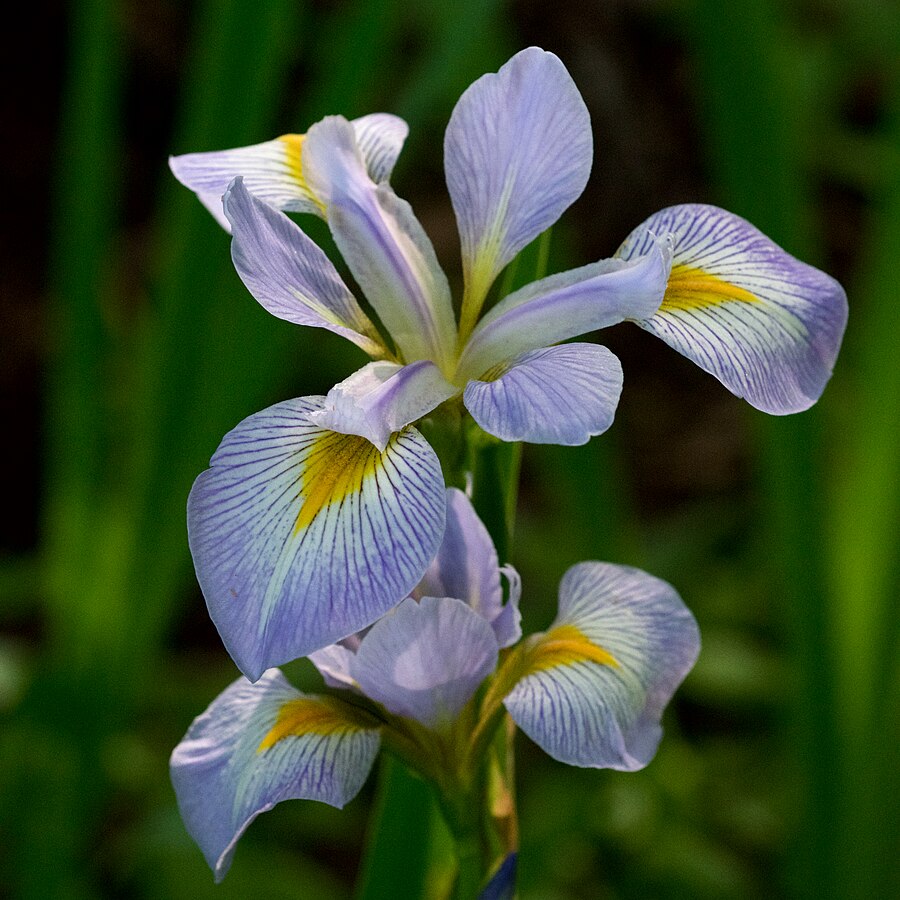A Salute to Southern Blue Flag

Iris virginica; photo by Eric Hunt, CC BY-SA 4.0, via Wikimedia
Iris, the Greek goddess of the rainbow, traveled between heaven and earth on a celestial curve of color, delivering messages from the Gods to their mortal subjects below. (She is also credited with refilling the clouds with water after it rains.) Wherever Iris set foot on Earth, a flower would grow – a souvenir swatch of the same color that swept across the sky in her wake.
One of those flowers is named after her. Iris virginica, a water-loving purple wildflower, is native to the Commonwealth of Virginia. Its common name is Southern blue flag, a reference to the reedy plants with long, slender leaves that the Anglo Saxons called “flagge”. The two species look alike and share a natural affinity for fresh to mildly brackish tidal marshes and wetlands like those found along coastal plains from Virginia to Texas and Canada.
Thomas Jefferson mentioned Southern blue flag on the opening page of his Garden Book, a horticultural diary where he recorded the planning and planting of his ambitious gardens at Monticello and Shadwell from 1776-1824. The iris was one of his favorites, with its small but showy blossoms that bloom in early spring, hovering 1-3 feet over clumps of bright green, sword-shaped leaves.
Iris virginica flaunts pale-blue to deep-purple flowers with three upright petals called “standards” which grow above three modified leaves called “falls.” While “falls” may look like petals, with their white veins and a conspicuous yellow patch, but are not. They droop downward or spread out, presenting a landing pad for the hungry bees who collect nectar and cross-pollinate the plant in the process. Butterflies, skippers and hummingbirds offer the same service on the fly.
In spite of its appeal, every part of Southern blue flag, from its flowers to its shallow roots, is toxic to humans and animals. Ingestion can cause stomach distress. Skin exposure results in mild irritation.
Deer and rabbits avoid Southern blue flag because it irritates their digestive tract. Muskrats, however, will make a meal out of the rhizomes while snails and slugs feast on its foliage.
Noxious or not, mankind has been cultivating Iris virginica for ornamental, culinary and medicinal purposes since the ancient Egyptians. In the southeastern United States, the Cherokee and other Native American tribes pounded its roots into a pasty ointment for skin and treated liver ailments with an infusion of iris root. The Seminole are said to have used Iris virginica to alleviate “shock following alligator-bite.” Other tribes twisted the outermost fibers of the leaves into twine and added powdered iris root to perfume and potpourri for its violet-like fragrance.
Southern blue flag is a sun-loving perennial, hardy in USDA Zones 5-9. In the wild, it thrives in a wide variety of wetland sites, including marshes, wet meadows, swamps, ditches, bottomland, pond edges and in as much as 6 inches of fresh water. Wherever it grows, it plays an important role in filtering water and stabilizing soil.
It wants the same wet conditions under cultivation. Plant it in masses along a pond margin, in a water garden, rain garden or native plant garden, or across any low-lying damp area. It will spread slowly by rhizomes, forming shallow colonies which can be divided for propagation in early fall when leaves begin to turn yellow.
To learn more about Iris virginica and 60-100 of her iris relatives, don’t miss the Central Virginia Society Show and Sale on Sunday, May 5 at Lewis Ginter Botanical Garden. As many as 200 irises, potted and ready to plant, will be for sale from 10 AM – 4 PM in the Robins Visitors Center Atrium. The American Iris Society sanctioned show, judged by an accredited official, will take place from 12 – 4 PM in the Robins Room. Both are open to the public and free to attend.
Anyone is eligible to enter the show. To submit an entry, bring your award-worthy iris, with its name, if possible, to the Robins Room during staging time on Saturday, May 4 between 3PM and 6PM or on Sunday, May 5 from 7AM to 10AM. There will be a special Youth Division for growers age 18 and under.
While you’re there, cast a vote for your favorite iris in the Robert Y. Sandford People’s Choice Award competition. And learn more from society members who will be available to answer questions about irises of all kinds.
For more about the show and sale, visit the Central Virginia Iris Society on Facebook.